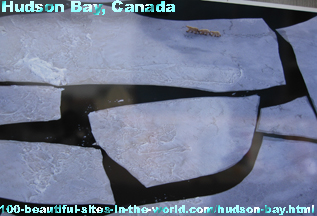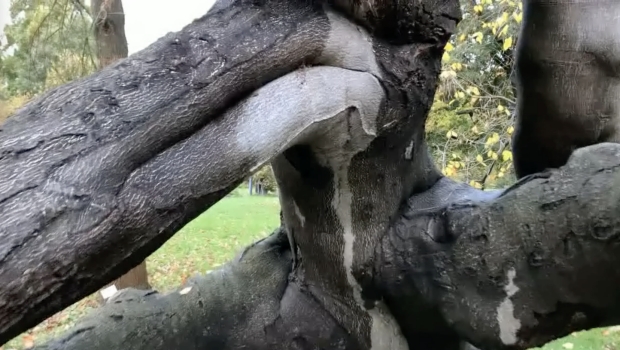Hudson Bay is at the Top of the Arctic Food Chain!
If you view Hudson Bay on the map, again you cannot assume that it lies in northeastern Canada. This bay shapes Canada differently and makes it a little challenging to indicate its location on the Canadian lands and waters. Let it to geographers to determine another look on this location.
Continue the article about this large inland bay below. If you have more information about it and the natural life around it, please use the form on this page to write it. I have some useful gifts for you when you contribute to this page. Those gifts are good just for knowledge or you can use them to improve your life. Thanks.

However, this large body of water, which comes after the Bay of Bengal is drainage to large areas in Canada that includes Nunavut at the top north, northwest, Ontario at the south, Quebec at the southeast, Manitoba at the southwest, almost all of which encircle the bay.
Hudson Bay is also one of a series of beautiful places in Canada on this website like Boreal Forest, Herschel Island, and Nunavut. Those pages are also included alphabetically in the Beautiful Site Map to facilitate your browsing.
The pages above are also included alphabetically in the Beautiful Site Map with so many pages to help you navigate the website easily.
Hudson Bay is 1,370 kilometres long and 1,050 kilometres wide, a large inland sea that almost encircled by lands even at its mouth that break into small archipelagos between the bay and between themselves all together.
Through those archipelagos, the waters of Hudson Bay join the Arctic Ocean at the top north west and the Baffin Sea at the west of Greenland; where Ilulissat and Zackenberg and the North Atlantic Ocean.
Ten of thousands beluga whales live in the bay in summers arriving from Churchill, Manitoba. The same area is home to Polar bears significantly making Hudson Bay as a domestic area to some hundreds of bears. However, only climate change is of great threat to those animal species.
The polar bear with its thick layer of blubber, two layers of fur, compact ears and small tail is perfectly adapted to survival in the cold north. Rather than cold, the problem of polar bear is overheating. Therefore, it prefers to move into a comfortable pace.
Polar bears roam the Arctic and surrounding waters, including Hudson Bay in Canada, which belongs to the southern polar bear's range. As the upper part of the food chain in the Arctic, polar bears spend most of the year on the frozen sea ice, where they hunt seals.
Using their excellent sense of smell, they track polar seals through their breathing holes in the ice. Here they wait patiently for hours or even entire days for the seals to come up to the surface to breathe.
In the western part of Hudson Bay, the ice begins to melt and break up in late spring. Until the sea freezes over again, the polar bears are barred to hunt seals, so they hibernate and live off their fat reserves.
With an estimated total population of 22,000-25,000, some studies have classified the polar bear as threatened species. Global warming today is the greatest threat to the polar bear.
Rising temperatures make the ice melt earlier and earlier each year, which means that polar bears cannot reach to build sufficient fat reserves, and at the same time forcing them to fast for longer periods.
The ice in western Hudson Bay breaks now three weeks earlier than in the early 1970s. Hunger hat has already reduced the cubs and young bear's survival rate and made bears generally unhealthy.
A decline that reaches more than 30% in the total polar bear population is expected within the next 35 to 50 years. It is possible that the polar bears will disappear from their well-known geographic range.
In addition to Hudson Bay, here are some relevant links to pages about some beautiful places in Canada, such as Boreal Forest, Herschel Island, and Nunavut.
What kinds of animals live in the area?
What kinds of fish species are in the Hudson Bay?
What kinds of bird species are in the area?
What kinds of plant species surround the area?
Please, either answer the questions or comment using the following form. You can write articles about Hudson Bay or the surrounding area through the same form. I have a thank you gifts waiting for you when you contribute to this page, adding more value to it. Thanks.
PLEASE BE ASSURED, no one of the commentators will capture your email address. It is only that the system that will send you notifications about replies to your comments, as this process is automated. Thanks to SBI 2.0 for offering the Web 2.0 strong tools and making nice visitors like you comment and share throughout the Web 2.0.
Have A Great Story About Some Beautiful Sites in the World?
Do you have a great story about any beautiful site in the world? Share it!
Search for any information about Hudson Bay, the Polar Bears or search inside any beautiful place in Canada.
You can also enjoy more activities here indeed if you liked this page about Hudson Bay in Canada.
Please share it with your services through the buttons here, at the left column of the page and at the bottom of the page.
This could be also additional value to you, as you could experience some social networking technologies and know more. Click on "Enjoy this page? Please pay it forward" at the bottom to know how to link to the website.
I use "Solo Build It" tools at the bar below to empower this page about Hudson Bay in Canada and the entire 100 Beautiful Sites in the World. Thanks to those strong website building and optimizing tools.
Home| 100 Beautiful Sites Blog| Beautiful Site Map| Beautiful Scene Newsletter| 350| Altai Mountains| Amman| Archipelago Sea| Arctic Ocean| Bayan Olgii| Bay of Plenty| Beijing| Bering Sea| Big Sur| Boreal Forest| Borneo| Cape Floral Region| Caracas| Caribbean Sea Turtles| Chacaltaya| Chigao| Congo River Basin| Copenhagen| County Meath| Dalarna| Franz Josef Glacier| Ganges Delta| Gondar| Great Barrier Reef| Herschel Island| Hudson Bay| Ilulissat| Indus River| Kakadu| Kalahari Desert| Kauai| Kilimanjaro| Komodo Island| Kordofan| Lake Baikal| Lake Chad| Lilongwe| Madagascar| Mergui Archipelago| Mississippi River| Monteverde Cloud Forest| Naukluft Park| Niger Delta| Norwegian Tundra| Nunavut| Okavango Delta| Olympia| Panama Canal| Paris| Perth| Quelccaya Ice Cap| Recife| Rio de la Plata| Ross Ice Shelf| Rotterdam| Rub al-Khali| Sagarmatha National Park| Saint Louis| Siberia| Solomon Islands| Sulu Sulawesi Sea| Thames| Tian Shan| Timbuktu| Tokyo| Trinidad| Tuvalu| Upper Po Valley| Valdes Peninsula| Vavau| Venice| Wadden Sea| Yamal Peninsula| Yangtze River| Zackenberg| Zahara de la Sierra|

